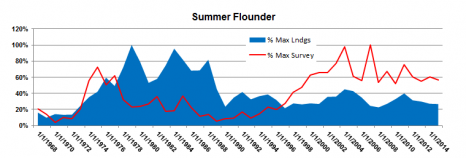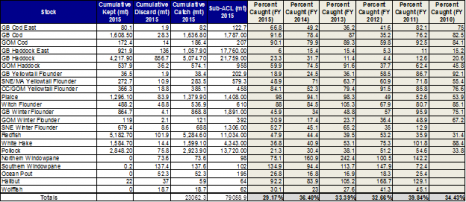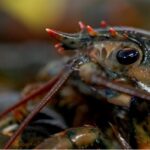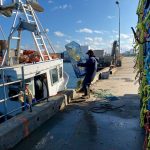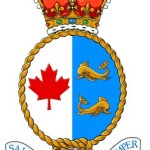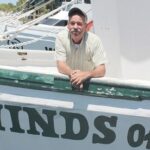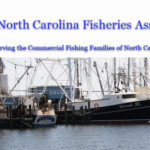Nils Stolpe: What’s so hard about managing fisheries?
 Nils Stolpe/FishNet USA May 3, 2017
Nils Stolpe/FishNet USA May 3, 2017
“We live in a world in which data convey authority. But authority has a way of descending to certitude, and certitude begets hubris. From Robert McNamara to Lehman Brothers to Stronger Together, cautionary tales abound. We ought to know this by now, but we don’t. Instead, we respond to the inherent uncertainties of data by adding more data without revisiting our assumptions, creating an impression of certainty that can be lulling, misleading and often dangerous. Ask Clinton” Stephens, B., Climate of Complete Certainty, NY Times, 4/28/17.
The above quote was from an op-ed piece by Bret Stephens, the New York Times’ recently acquired columnist. While he was targeting climate scientists, their “disciples” and the overblown pseudo-science hidden beneath an oversufficiency of less than convincing statistics that is used to strengthen their arguments, it appears that fisheries scientists are increasingly adopting the same techniques (the emphasis is mine) to support their often erroneous – sometimes sadly so – conclusions.
“NMFS proposes revised black sea bass specifications for the 2017 fishing year and projected specifications for 2018. In addition, this rule proposes to remove an accountability measure implemented at the start of the fishing year designed to account for commercial sector overages in 2015. Updated scientific information regarding the black sea bass stock indicates that higher catch limits should be implemented to obtain optimum yield, and that the accountability measure is no longer necessary or appropriate…. The (Mid-Atlantic Fishery Management) Council and the (Atlantic States Marine Fisheries) Commission’s Summer Flounder, Scup, and Black Sea Bass Management Board met jointly on February 15, 2017, to consider the SSC and Monitoring Committees’ recommendations…. The Council’s recommendations represent a 53-percent increase in the 2017 commercial quota established in 2015 and a 52-percent increase in the 2017 recreational harvest limit. (from Fisheries of the Northeastern United States; Black Sea Bass Fishery; 2017 and Projected 2018 Specifications, Federal Register / Vol. 82, No. 71 / Friday, April 14, 2017 / Proposed Rules).
The above adjustment would apply to black sea bass, an important commercial and recreational fishery in the Mid-Atlantic. When it is implemented the value of the commercial black sea bass fishery in the Northeast, based on 2015 across-the-dock prices, would be in the neighborhood of $15 million. In 2015 the value of the commercial black sea bass fishery in the Northeast was approximately $4.5 million. Before the results of the new stock assessment, the impetus for the above adjustment, were available the commercial landings for 2017 were set to be under $7 million.
The recreational fishery will get a comparable increase.
Summer flounder, black sea bass and scup are all managed under the same fishery management plan, which with amendments has been going on for almost 30 years.
Last autumn I described in Summer Flounder Management – Can it get any worse? (available at http://www.fishnet-usa.com/SummerFlounder_AnyWorse.pdf) how another important mid-Atlantic fishery over the same period was subject to a greater than 50% quota cut over a two year period. And, like the black sea bass quota, though with much less desirable results, the quota change was mandated with minimal lead time.
Imagine what the effects of these drastic changes in supply in these fisheries have been/will be on the people, the businesses and the communities that depend on them. I doubt that the federal government could come up with any other management strategy, short of an out and out harvest moratorium, that would be more damaging to fishing and fishing dependent businesses. Successful businesses depend on predictability; predictable supplies at predictable prices and with predictable markets, and in fisheries the federal government has been far to capable of delivering unpredictability since the passage of the Sustainable Fisheries Act in1996. In certain fisheries unpredictability seems to be the rule rather than the exception.
Fisheries management minus the overblown science, bureaucratic bluster and ENGO manipulation
In theory, there’s not much involved in effective fisheries management. All that’s required is the wherewithal to accurately estimate the condition of the fish/shellfish stock or stock complex you are managing on an annual basis, an accurate determination of the fishing mortality you will allow, and a mechanism to maintain, increase or decrease the mortality level dependent on the following fishing year’s mortality.
Obviously this management scenario assumes that there is a relationship between the status of the stock being managed and the fishing mortality, perhaps not expressed immediately but surely after a lag time of a year or two (arguably that’s not always the case, but that’s a whole other story).
But, as the current summer flounder/black sea bass situation so clearly demonstrates, today this is far beyond the capabilities of our federal fisheries managers and our federal fisheries management system.
Back to summer flounder (yet another Never Ending Story)
Let’s use summer flounder management as an example of what supposed “state of the art” fisheries management looks like. Below I’ve graphed the results of the summer flounder component of the Northeast Spring and Autumn Bottom Trawl Surveys – supposedly one of the best (i.e. most accurate/longest running) fish surveys we’ve got (http://www.nefsc.noaa.gov/publications/crd/crd1221/t36thru37.pdf). I’ve also graphed the summer flounder landings from the NMFS on-line landings database (https://www.st.nmfs.noaa.gov/commercial-fisheries/commercial-landings/) for the past 40+ years. (The commercial landings and the survey results are expressed as percentages of the maximum survey catch – 2008 – and the maximum landings – 1979 – for the period).
Below are charts of landings and survey results in three logical periods based on what have to be considered as revolutionary changes in how we manage or don’t manage fisheries. These are pre-Magnuson (Figure 1 below), post-Magnuson/pre-Sustainable Fisheries Act (Figure 2) and post-Sustainable Fisheries Act (Figure 3). Blue are survey samples (as the % of the maximum survey sample weight in the respective period) and red are landings (as the % of the maximum landings weight in the respective period).
Using linear trend lines a la MS Excel, there appear to be relationships between the bottom trawl survey results and harvest for summer flounder prior to the passage of the Magnuson Act in 1976 (survey catch and commercial landings both increase) and post-Magnuson/pre Sustainable Fisheries Act (survey catch and commercial landings both decrease). In the period following the passage of the Sustainable Fisheries Act in 1996 the survey results increase dramatically while commercial landings remain flat.
Since the beginning of the annual Northeast bottom trawl surveys and commercial landings tracking began (at least until the Sustainable Fisheries Act was passed in 1996) there’s been an apparent relationship between the estimated summer flounder population size and the harvest. At first – Fig. 1 above – from 1968 to 1975 and with minimal management measures, the population increased and the landings increased correspondingly. Then in 1976 – Fig. 2 – with the advent of Magnuson management and with an increase in effort that came about in just about every federally managed fishery because of its provisions, the population decreased and the landings followed suit. That’s the way it’s supposed to work. But as Fig. 3 above indicates, since the SFA was enacted it no longer works that way. The weight of the summer flounder sampled, hence the biomass, has increased steadily and seemingly consistently in spite of the switch from the R/V Albatross to the R/V Bigelow, yet landings have remained flat.
(I’ll note here that I have had a request in to the survey people at the NOAA/NMFS Northeast Fisheries Science Center for two months or so for survey results for other northeastern fish species but have yet to receive anything in return other than an acknowledgement that the request was received.)
While it might be ill-advised to generalize from a single FMP, some things seem apparent
First off, and possibly most importantly, after the passage of the Magnuson-Stevens Act and before the passage of the Sustainable Fisheries Act (SFA) the Regional Fisheries Management Councils had significant latitude in interpreting the information that was presented to them from the scientific/academic community and the “anecdotal” input from people knowledgeable in fisheries on both sides of the Council table. On-the-water observations and (sometimes multi-generational) knowledge wasn’t automatically discounted as it is far too often of late. The Councils’ job was to consider all of the information presented to them and to determine their management strategy accordingly (bear in mind that both then and now the Councils only made/make recommendations to the Secretary of Commerce, who has been and still is ultimately responsible for management decisions).
Since 1996 and the SFA, management has been completely different – though as Fig. 3 above seems to indicate, it certainly hasn’t been more effective, at least from what used to be the acceptable “if there are more fish, fishermen should be allowed to catch more” pre-SFA perspective. Now scientists have much more input and much more influence, learned judgment, which is still referred to deprecatingly as “anecdotal information” takes a far back seat, and statistics, no matter how inadequate, reign.
Hence the huge, and costly, changes in management parameters based on reassessments and reinterpretations and “uncertainty” penalties. Looking at summer flounder and black sea bass, the scientists appear to be clueless from year to year and yet luxuriate in a system in which the only accountability is borne by the fishermen.
As I have written before, what passes for fisheries management in the U.S. today has been purposefully distorted by anti-fishing activists (misrepresenting themselves as marine conservationists) into a top-heavy bureaucratic system that is focused almost completely on preventing “overfishing,” regardless of the effects this monomaniacal focus has on domestic fishermen and domestic fishing businesses. In the distorted view of these “conservationists,” overfishing should be classified as one of the Cardinal sins, and there should be no acceptable excuse for allowing it to happen in any of our domestic fisheries.
The end result of their successful selling of this view to the unknowledgeable is totally unrealistic harvest restrictions which make it increasingly difficult – and increasingly, impossible – for domestic fishermen to remain in business. And not too surprisingly, of having over 90% of the seafood sold in the U.S. being imported.
To give you an idea of what constitutes federal fisheries management today, the post-SFA managers will start out with the determination of the Overfishing Limit (OFL) in a fishery. The OFL is equivalent to the Maximum Sustainable Yield (MSY), the maximum amount of fish that can be sustainably harvested from a given stock of fish.
But the OFL is then reduced to what is termed the Acceptable Biological Catch (ABC). This is the OFL reduced by “Scientific Uncertainty.”
Scientific uncertainty refers to uncertainty in the information about a stock and its maximum sustainable yield reference points. Sources of scientific uncertainty could include: uncertainty in stock assessment results; uncertainty in the estimates of maximum fishing mortality threshold, maximum stock size threshold, the biomass of the stock, and overfishing limit; time lags in updating assessments; the degree of retrospective revision of assessment results; uncertainty in projections; uncertainties due to the choice of assessment model; longer-term uncertainties due to potential ecosystem and environmental effects; or other factors (http://www.nmfs.noaa.gov/sfa/
management/acls_ams/setting_ acl.html).
Then the ABC is further reduced by management uncertainty to the Annual Catch Target (ACT).
Management uncertainty refers to uncertainty in the ability of managers to constrain catch so that the annual catch limit is not exceeded, and the uncertainty in quantifying the true catch amounts (i.e., estimation errors). The sources of management uncertainty could include: late catch reporting; misreporting; underreporting of catches; lack of sufficient in-season management, including in-season closure authority; or other factors (ibid.).
So, because the various individuals, agencies and organizations aren’t particularly good at what they do, the harvest is just about always reduced to far under the MSY level. And then, following what is termed a “retrospective analysis,” it may be reduced even farther. Quoting from the Summer Flounder Stock Assessment Update for 2016 (https://tinyurl.com/
The consistent pattern in the underestimation of F (Fishing Mortality) and the overestimation of SSB (Spawning Stock Biomass) noted for the last several terminal years has continued. Moderate internal model retrospective patterns in F and SSB are evident in the updated assessment model, as the average retrospective errors over the last 7 terminal years are -20% and +11%, about twice as large as the magnitude of the 2013 SAW 57 retrospective errors.
The Chairman of the Mid-Atlantic Council’s Scientific and Statistical Committee (SSC) wrote in a July 26, 2016 memo “the revised understanding of the stock status produced by the assessment update indicates reductions in the estimates of SSB (spawning stock biomass), and increases in the estimates of annual Fs (fishing mortality).” Naturally, the way the management system was biased against fishermen and fishing dependent businesses in 1996 in the SFA, this necessitated an immediate and as drastic as necessary correction. So, because the scientists presumably got it wrong in 2013 and then presumably got it right, (or, as the SSC Chairman wrote, developed a “revised understanding”) in 2016 the summer flounder harvest was reduced 27% for the 2016 fishing year and 31% for the 2017 fishing year.
If it was only summer flounder…
In tabular form for four major mid-Atlantic fisheries the reductions from the MSY for 2017 in millions of pounds are as follows (the MSY of Black Sea Bass wasn’t determined so the percentage of the ABC was used. The chart was compiled before the increase in the black sea bass harvest was proposed):

For these four mid-Atlantic fisheries the Total Harvest ranges from slightly over half (56%) to two thirds of the Maximum Sustainable yield.
Assuming an average value of $2.50 per pound for the four listed species, the fact that the scientists and managers aren’t particularly effective at counting fish in the ocean or on the dock will cost the mid-Atlantic fishing industry over $60 million in 2017. Assuming that a pound of recreationally caught fish is as valuable as a commercially caught fish and assuming a 5:1 multiplier for economic activity generated by fish landings, that’s a third of a billion dollars lost to the coastal economy in the Mid-Atlantic and Southern New England in a single year in only four fisheries.
How well is the summer flounder, scup and black sea bass FMP working?
“Since 1987, when the Summer Flounder, Scup and Seabass Fishery Management Plan was approved by the U.S. Secretary of Commerce, a series of at least 100 meetings resulted in more than 8,000 typed pages devoted largely (but not exclusively) to summer flounder management. Assuming at least a dozen attendees at each of those meetings, a two day investment of time, travel expenses and etc. by the participants and the cost of writing, editing and distributing those 8,000 plus pages, the cost to the taxpayers must be well into six figures.” (From Summer Flounder Management – can it get any worse? at http://www.fishnet-usa.com/
SummerFlounder_AnyWorse.pdf).
After almost 30 years of intensive management, in two consecutive years the federal managers – bureaucrats and scientists – missed, or determined that they had missed, the condition of two of the three stocks being managed in the FMP by such a wide margin that in one the allowable harvest had to be cut by more than half and in the other the harvest had to be doubled. In case you missed it the first time, that’s after almost 30 years of intensive management! Not much onward and upward there, is there?
And what about underfishing?
And then there are the harvest restrictions that come into play after the allowable harvests are determined by accounting for scientific and management uncertainty. These generally involve the cessation of harvesting of a target species because of the incidental catch of other species (bycatch of so-called “choke species”) in that fishery. The chart below shows what the Annual Catch Limits were for the species managed under the New England Fishery Management Council’s Northeast Multispecies Fishery Management Plan in 2015. In fishing years 2011 to 2015 New England fishermen caught between 29% (in 2015) and 39% (in 2011) of what they potentially could have caught but didn’t because of the bycatch of “choke” species reaching their limits or because of lack of markets for the targeted species (https://www.greateratlantic.
Because of artificial restrictions on harvesting, perhaps half of what would be the total, scientifically justified (before scientific and management uncertainties are allowed for) allowable catch remains unharvested each year. In the Northeast the value of landings in 2015 were $1.5 billion, using a 5:1 multiplier generating on the order of $7.5 billion in economic activity. It’s plain that those landings could approach $3 billion, generating $15 billion in economic activity, 1) if fisheries scientists were better at estimating fish population , 2) if the slight risk of overfishing was accepted each year and effective provisions for dealing with that risk in one or two subsequent years were mandated, and 3) if the totally nonsensical idea that even inconsequential species should be at levels that would allow for their harvesting at MSY levels was discarded, to be replaced by the requirement that their harvesting wouldn’t threaten the continuation of the species.
Do you think a fresh start might be indicated?
Reduced to an elementary level, what if the summer flounder allowable catch in the Northeast was set at the Maximum Sustainable Yield/Overfishing Limit of 16.76 million pounds rather than at the “safe” level (allowing for scientific and management uncertainty) of 9.43 million pounds? There is a probability that the 16.76 million pounds would be a safe level of harvest – no overfishing. There is also a probability that that level of harvest would allow overfishing.
If there was no overfishing everything would be fine. If there was overfishing the amount by which the quota was exceeded would simply be deducted from the quota for the next year (or the next two or three years). There would be no loss; the summer flounder fishery would be ahead by 6 million pounds or so – $15 million to the industry and $75 million in increased economic activity spread out from North Carolina to Southern Massachusetts. Reducing a quota for one year because the quota was exceeded in the previous year is something that’s regularly done in various federally managed fisheries. It isn’t anything like a big deal, but rather is a routine adjustment. Is there a difference if the quota is set at the MST/OFL level instead of millions of pounds less than that? Except for the lost income there isn’t.
And this isn’t a problem that is restricted to the Northeast (see Ray Hilborn’s comment on West Coast groundfish on the CFood website (http://cfooduw.org/west-
How fisheries management could (should?) work
The initial step in every fishery would be the design of a species-specific sampling/assessment process by a panel of stake holders and scientists. With the results of this process in hand an initial TAC would be set and initial management measures designed allowing this TAC to be caught would be put in place. In each subsequent year the stock would be assessed and the TAC would be adjusted accordingly (if assessment results were lower the TAC would be decreased, if higher the TAC would be increased, if the same the TAC would remain unchanged).
Considering the spectacularly inadequate performance of the existing assessment/management process – severe underfishing in fishery after fishery, huge harvest adjustments in either direction because of “retrospective analyses” or “revised understandings” – could such a simple system perform more poorly? It would certainly be more affordable, in all likelihood it would be more acceptable to the resource users, it would definitely be more understandable to the public, and think of all of the bureaucratic/scientific salaries and all of the trees that would be saved.
Each year thousands of tons of finfish and shellfish remain unharvested because of a totally unjustified fear of overfishing, a fear that has been created by the anti-fishing community with the complicity of bureaucrats, scientists and politicians who are orders of magnitude more concerned with avoiding the slightest hint of overfishing than they are with the vitality of our fishing industry.
It’s time that we treated overfishing for what it really is. It isn’t a precursor to extinction or a threat to sustainability, it’s a fisheries management misstep that, with proper safeguards in place, will be obviated in a year or two with absolutely no permanent or even lasting damage to our stocks of finfish and shellfish. The only damage – if it could be considered as such – would be due to the long overdue recognition of the redundancy of the doom-predicting anti-fishing activists who have built careers and bureaucracies on preventing overfishing.






